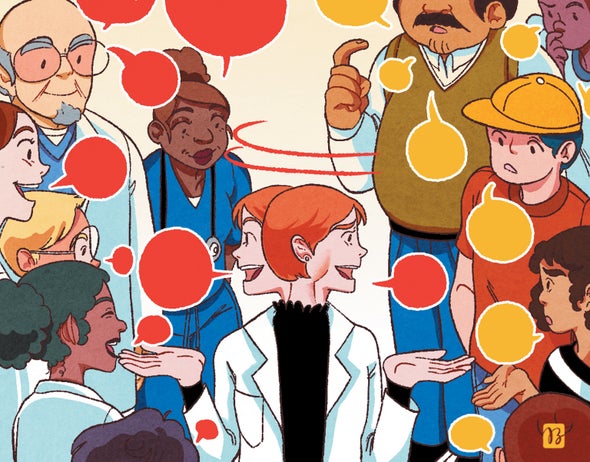With the persistence of vaccine denial, as well as many Americans still reluctant to face the facts of climate change even in the face of devastating floods and record-breaking heat, social media has been suffused with theories about why people don't trust science. In my own work, I have talked about how 40 years of partisan attacks on government have led to distrust of government science and then of science generally.
But this past year another issue has been bugging me. It's the way scientists talk. This is not a new concern. Many years ago science writer Susan Hassol and atmospheric scientist Richard Somerville wrote a humorous but serious piece about how the terms that climate scientists use mean one thing to them but often something very different to others. In the climate system, for example, “positive feedback” refers to amplifying feedback loops, such as the ice-albedo feedback. (“Albedo,” itself a bit of jargon, basically means “reflectivity.”) The loop in question develops when global warming causes Arctic ice to melt, exposing water that is darker and reflects less of the sun's warming rays, which leads to more warming, which leads to more melting ... and so on. In the climate system, this positive feedback is a bad thing. But for most, it conjures reassuring images, such as receiving praise from your boss.
Hassol and Somerville call this “speaking in code.” Codes, of course, are intended to be opaque to outsiders, but some scientific language is impenetrable even to many insiders. Consider the “secondary maximum contaminant level,” or SMCL, used by the U.S. Environmental Protection Agency. Primary maximum contaminant levels (MCLs) are the maximum levels of contaminants allowed in drinking water, based on scientific evidence of health threats.
So what is a secondary standard? It's something established for reasons that do not affect public health—at least not directly. The EPA has recognized three distinct types of concern that can trigger an SMCL: Aesthetic issues that involve the appearance, odor or taste of the water; cosmetic issues that can affect your appearance, such as silver, which can cause argyria (a condition in which your skin turns irreversibly blue); and technical issues that involve damage to equipment. The agency is lumping three very different concerns under one term that communicates none of them. I don't know about you, but I wouldn't care if silver in my tap turned my water a bit blue. I would care if it turned me blue. And I would certainly care if damage to equipment led to my water carrying dangerous amounts of lead.
Examples of confusing and misleading scientific terms abound. When astronomers say “metals,” they mean any element heavier than helium, which includes oxygen and nitrogen, a usage that is massively confusing not just to laypeople but also to chemists. The Big Dipper isn't a constellation to them; it is an “asterism.” Computational scientists declare a model “validated” when they mean that it has been tested against a data set—not necessarily that it is valid. In AI, there is machine “intelligence,” which isn't intelligence at all but something more like “machine capability.” In ecology, there are “ecosystem services,” which you might reasonably think refers to companies that clean up oil spills, but it is ecological jargon for all the good things that the natural world does for us. And then there's my favorite, which is especially relevant here: the theory of “communication accommodation,” which means speaking so that the listener can understand.
Studies show that alien terms are, in fact, alienating; they confuse people and make them feel excluded. One study showed that even when participants were given definitions for the terms being used, jargon-laden materials made them less likely to identify with the scientific community and decreased their overall interest in the subject. In plain words: jargon turns people off.
Of course, there are words with specific technical meanings that cannot be otherwise easily expressed (look up “holobiont”), and astronomers may have a good reason for preferring the parsec (which equals 3.26 light-years) to the familiar light-year. Technical terms used in regulatory contexts may be hard to change for legal reasons. But if scientists could speak plainly, it would help us understand their claims and better appreciate their work.


